Fascination About Snake Plant Leaves Turning Yellow
Wiki Article
All About Snake Plant Leaves Turning Yellow
Table of ContentsThe 9-Second Trick For Snake Plant Leaves Turning YellowThe Greatest Guide To Snake Plant Leaves Turning YellowWhat Does Snake Plant Leaves Turning Yellow Do?Things about Snake Plant Leaves Turning YellowTop Guidelines Of Snake Plant Leaves Turning Yellow5 Simple Techniques For Snake Plant Leaves Turning Yellow
If overwatering in serpent plants is not dealt with, the yellow patches of your mother-in-law's tongue plant will certainly turn dark brownish or black. To eliminate any type of various other root causes of snake plant fallen leave yellowing, eliminate the plant from its pot and check the origins to see if they're soaked and have a foul smell.
Here's just how to conserve a serpent plant that's transforming yellow: Stop watering your snake plant until the soil dries out up completely if the yellowing is due to overwatering. Return to watering, yet not greater than when weekly. As a regulation of thumb, avoid sprinkling your snake plant up until the leading 2 inches of the dirt really feel dry.
A Biased View of Snake Plant Leaves Turning Yellow
This will certainly aid to boost drain rates, considering the high temperature and sunlight conditions during the day. Proper water drainage entails making use of a fast-draining dirt mix and a growing pot with drainage openings at the base. It is best to use a dirt mix that includes perlite and crude sand for rapid water drainage.There's a positive side as you can expand brand-new plants by proliferating the few continuing to be leaves that are still healthy and balanced. References.

Water is important in soaking up nutrients required for chlorophyll. Lack of water triggers the disintegration of chlorophyll.
All About Snake Plant Leaves Turning Yellow
Snake plants enjoy a moist, not soggy, and you should not permit the potting mix to dry out completely for a long time. We advise sprinkling your serpent plant after the dirt dries out totally or most of it is completely dry.A substantial one may trigger overwatering, and if it is as well tiny, your plants will dry swiftly. When watering, saturate the dirt up until excess water originates from drain holes. Pour any type of water that accumulates on the saucer. Finally, never comply with a serpent plant sprinkling session. Instead, always feel to make certain the potting mix is dry a minimum of half-down the pot.

The 10-Minute Rule for Snake Plant Leaves Turning Yellow
You can also obtain cool frames. In warm summertimes or during warm waves, take your plants to cooler places. Do not place your plants near house heating system vents, radiators, fire places, or anything that releases warm. Lastly, stay clear of temperature abrupt decreases and spikes. They will stress your plant.An absence will trigger in-between blood vessels yellowing on young leaves. When it is lacking, plants accumulate nitrates but fail to use them to make healthy proteins.
Also though snake plants have a document for being almost difficult to kill, they however experience a fair share of issues. Snake Plant Leaves Turning Yellow. You are not the only one who has observed that your snake plant's fallen leaves are transforming yellow. We will certainly take a look at get redirected here the factors snake plant leaves turn yellow and how to handle it
The Single Strategy To Use For Snake Plant Leaves Turning Yellow
Since snake plants are vulnerable to root rot, they will certainly not grow if watered exceedingly. This is commonly the ideal balance if you allow your plant dry but do not allow it stay dry. You can water your plant again as soon as the soil appears dry to the touch.A damp container will certainly weigh substantially larger than a completely dry pot, so eventually, you should certainly be able to establish how completely dry your plant is based on the mass of its container. Serpent plant leaves might become yellow if you let your plant completely dry out, then wait until the dirt is entirely dry prior to rewatering.
You require to take into consideration even more than just exactly how often you water snake plants. You additionally need to consider what strikes the liquid when it is positioned in a fantastic read the pot. After sprinkling your plant, you need to not let the origins linger in water for a few days since this can trigger origin rot.
Snake Plant Leaves Turning Yellow Can Be Fun For Anyone
Yellowing fallen leaves can be treated by offering the snake plant the appropriate environments and attention. Below are some of the reasons snake plants turn yellow and soft.You only need to supply adequate supply and ensure appropriate drainage to enable the additional water to drain pipes out. Not too much nor inadequate; there will certainly be an ideal environment for fungi ailments if there is any type of standing water. The serpent plants can be sprinkled every 2 to 6 weeks.
After positioning them in the early morning sunlight, you will notice that serpent plants' development price would enhance and appear healthier. Nevertheless, placing them in the outside morning sunlight will require much more water, so once per week suffices. Nevertheless, if the area gets excessive sunlight and the surface area feels dry, you can water them two times each week.
Report this wiki page